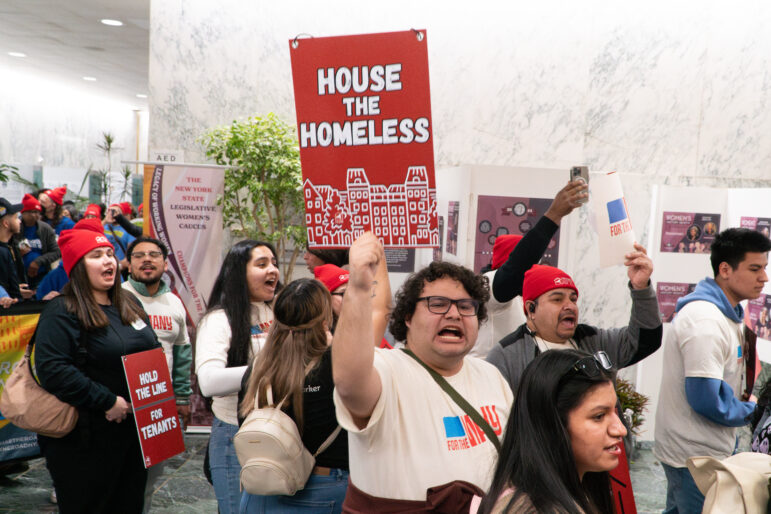Mayor Bloomberg last week announced the opening of 69 schoolyards for public use – nearly a quarter of the total he promises to open as part of the “Schoolyards to Playgrounds Initiative.” A new report from the Center for New York City Affairs at The New School, “A Schoolyard in Brooklyn: Strengthening Families and Communities Through the Innovative Use of Public Space,” looks in depth at the process by which a forbidding after-hours space became a necessary recreation and gathering place in Sunset Park.
Here is an excerpt:
Schoolyards are a tremendous potential resource for New Yorkers, not simply for all-important recreation but also for building stronger communities and supporting resilient families. Today, hundreds of such yards are closed to the public, even during the hours when schools are not in session. The story in these pages describes a vision for public space that evolved over many years of practical experience in a schoolyard in Brooklyn. Community leaders, young people, school staff and the parents who helped to create Neighborhood Center at PS 503/506 were constantly learning new lessons about what was possible, what was desirable and what it would take to create a space that was attractive and useful to thousands of people of all ages and backgrounds. Today, these lessons are essential knowledge for administrators and citizens citywide.
LESSON 1: City Hall must establish clear roles and responsibilities for maintenance and management of these public spaces. In the past, a persistent lack of clarity (and relentless gear-grinding of government bureaucracy) made it difficult for neighborhood residents to fully benefit from the shared use of schoolyards. Who will make routine repairs and clean up each day? Who will decide when yards can be reserved exclusively for after school and summer camp programs? Most importantly, who will define the rules governing the relationship between the community and the school? Multiple agencies and organizations are bound to be involved, ranging from the Department of Education to the Department of Parks and local community groups. Each of them needs to have a say, know their role and live up to it.
LESSON 2: Each schoolyard opened to the public needs a specific plan for establishing clear rules and lines of authority in the play area. Who will decide—and enforce—what games are acceptable? How will toddlers be protected from flying soccer balls and hard-hit baseballs? Who will define what games are played at what time? How do people sign up to use a field or basketball court? Who has the authority to remove rowdy players who flout the rules? In Sunset Park, Brooklyn, leaders of the community organization overseeing the schoolyard took on this role in collaboration with young people and parents. Once rules were established and enforced, the yard became safer and more attractive to a large and diverse group of people—and was no longer the exclusive playground of a relatively small group of young men. For reserving playing fields and courts, simply establishing a permit process is not enough—active oversight is required so those with the rights to the space either use it or lose it to others in a fair and orderly way. Community-based organizations are often better placed than the Department of Parks to keep control of this process.
LESSON 3: City Hall should make large schoolyards more family-friendly, attractive and usable by young children and teens, parents and caregivers. These yards can be transformative places for neighborhoods and families, controlled areas where parents and grandparents are sure their young children are safe, even as they keep a distant eye on their older children and spend time with their friends and neighbors. Community programs can take root for young and old alike, from gardening to reading programs to arts and crafts, alongside athletic activities. But this requires that local administrators plan and manage the space for people of all ages and multiple interests, not just for those who want to play organized sports.
LESSON 4: Organizers must promote values of community ownership to protect against vandalism. In Sunset Park, the more invested local residents became, the more likely they were to keep an eye on the playground after dark and report vandalism. Community organizing around the design of capital improvements—as the Trust for Public Land has proven—is one way to build community investment and ensure that schoolyards become the kind of place neighborhood residents want to spend time. But this engagement must continue over time. Community organizations should have city government support to develop structures for youth leadership, youth employment and parent involvement in setting rules and setting up programs connected to the schoolyards.
LESSON 5: Wherever possible, City Hall should tap community-based organizations to play the role of schoolyard organizer and manager. Many community organizations are well-placed to mediate among local residents, schools and other government agencies that may oversee the properties. Organizations that already hold city contracts for Beacon School, after school and other programs can help gather the modest resources necessary for collaborating with local parents and youth in order to provide consistent oversight during non-school hours, help to establish rules that are honored by participants and solve problems as they arise. The Beacons are great places to start—they are open evenings, weekends and in summertime, exactly the times when these schoolyards can best serve New York’s families.
LESSON 6: City Hall should establish schoolyard management as an element of Department of Youth and Community Development (DYCD) contracts with community-based organizations. The department already oversees contracts with organizations in after school programs, Beacons, Summer Youth Employment and many other areas that overlap directly with the ideal uses of these schoolyards. The agency is well-structured to support community groups, unlike the departments of education and parks. Many DYCD contract organizations also have community advisory councils, which should be expanded to include school administrators and other schoolyard stakeholders.








